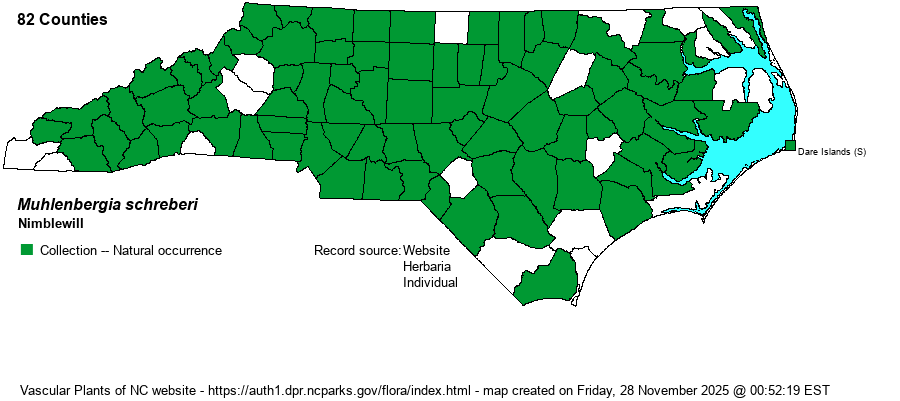| Author | J.F. Gmelin | |
| Distribution | Throughout the state; scarce in the Sandhills proper, rare on the Outer Banks.
ME to southern Ont. and SD, south to central FL and TX; southern Mex. | |
| Abundance | Frequent to common, except rare in the Sandhills and rare on the Outer Banks. | |
| Habitat | In a variety of situations, from moist bottomlands to dry uplands, old woods roads, trailsides, logging roads, clearings. This is our weediest native muhly. | |
| Phenology | Flowering and fruiting August-October. | |
| Identification | This multi-stem plant usually sprawls on the ground and roots at the nodes. Numerous flowering branches ascend or some may be erect. Leaves are short (a maximum of 4 inches long), narrow, and plentiful. The inflorescences are mostly terminal, with short branches appressed against the stem. From our other muhlys with narrow inflorescences, it can best be told by its tiny glumes (less than 0.5 mm long versus greater than 1 mm long in others). | |
| Taxonomic Comments | None
In NC the genus Muhlenbergia assumes 2 very different forms of inflorescences: very open and airy or narrow and elongate, with short branches. In both cases, attention to details of the key is important, along with a dissecting scope. Once learned, however, most muhlys can be identified on sight in the field. Spikelets contain a single floret (rarely 2-3). | |
| Other Common Name(s) | Nimblewill Muhly. Though the editors would prefer to use a non-idiosyncratic name -- at least by adding the word Muhly to this plant's common name, the species is almost universally named as Nimblewill in references. | |
| State Rank | S5 | |
| Global Rank | G5 | |
| State Status | | |
| US Status | | |
| USACE-agcp | FAC link |
| USACE-emp | FAC link |

